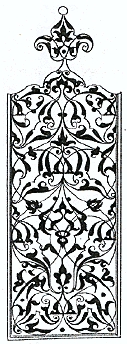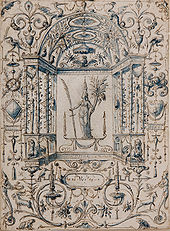Moresque
Other similarly derived words include Blackamoor, Kammermohr, Matamoros, Maure, Mohr im Hemd, Moresca, Moresche, Moreška, Morianbron, Morisco, Moros y cristianos, and Morris dance.
Another, related, meaning was defined in 1611 by Randle Cotgrave's A Dictionarie of the French and English Tongues as: "a rude or anticke painting, or carving, wherin the feet and tayles of beasts, &c, are intermingled with, or made to resemble, a kind of wild leaves, &c."[1] The word was also used for such a figure, starting off as a human or animal, but terminating as part of a decorative scheme of foliage or geometric strapwork.
In fact the origin of figures like those described by Cotgrave comes not from the Islamic world, but from the Renaissance version, influenced by the Ancient Roman grotesque decorative style, of medieval ornament, especially that found in illuminated manuscripts.
Here men and beasts whose forms disappear into geometric or foliage decoration go back almost a thousand years to the interlace of Insular art seen in the Book of Kells and other manuscripts.
Tooled and decorated fine bookbindings and printer's ornaments marking the end of a chapter were one of the first places where the style appeared, in 15th century Italy.

